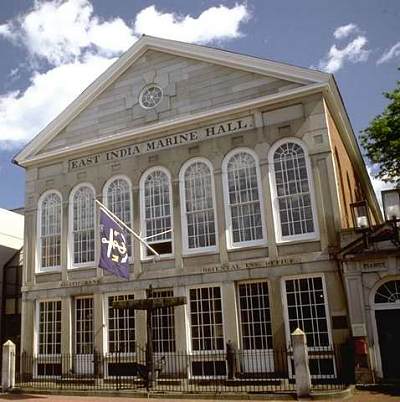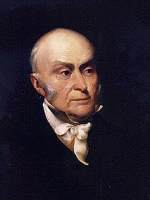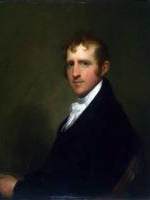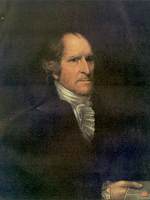East India Marine Hall
- Home
- About Salem »
- Salem Tales »
- East India Marine Hall
East India Marine Hall
Dedicated in 1825
The reopening of the stunning “new” Peabody Essex Museum in June 2003 calls to mind another related event that took place in 1825 — the completion and dedication of the oldest of the PEM’s gallery buildings, the East India Marine Hall.
The hall was a by-product of the East India Marine Society, which was organized in 1799 and incorporated early in the following year. Membership was limited to ships’ masters or supercargos who had sailed around either Cape Horn or the Cape of Good Hope.

Photo: Jim McAllister
The purposes of the society were to share navigation information relating to the East Indies; to provide benefits to members who had been disabled or to the families of members who had died; and “to form a Museum of natural and artificial curiosities, particularly such as are to be found beyond the Cape of Good Hope or Cape Horn.”
The collecting of curiosities would create an ongoing space problem for the East India Marine Society. The organization initially rented rooms in the Stearns Block in Town House Square, but their stay there was short-lived. As the number of donated items grew, the group began looking for larger quarters. In 1804 the society moved into the Salem Bank Building on Essex Street, just west of the future East India Marine Hall.
By 1824 the collections of the East India Marine Society had grown to nearly 3,000 items, and Dr. Seth Bass had been hired to organize and oversee the diverse inventory. Visitors flocked to the Essex Street museum to see war clubs, masks and costumes from far-away island kingdoms; models and paintings of local ships; and even a coffee cup and saucer once owned by Napoleon Bonaparte.
Desperately in need of more space, members of the East India Marine Society formed a separate corporation for the purpose of erecting a facility to house the society’s collections. The society itself had first option on the 150 shares in the new corporation; the rest were offered to members and interested citizens.
Construction of the 100-by-45-foot granite building was completed by October of 1825. The identity of the architect who designed the new hall is still a mystery today.
The stunning new East India Marine Hall was dedicated on Oct. 14, 1825. On hand for the festivities were President John Quincy Adams, Boston Mayor Josiah Quincy and Harvard President Kirkland. Salem’s own Joseph Story, associate justice of the U.S. Supreme Court, and Timothy Pickering also participated in the dedication day events.

John Quincy Adams
The purposes of the society were to share navigation information relating to the East Indies; to provide benefits to members who had been disabled or to the families of members who had died; and “to form a Museum of natural and artificial curiosities, particularly such as are to be found beyond the Cape of Good Hope or Cape Horn.”
The collecting of curiosities would create an ongoing space problem for the East India Marine Society. The organization initially rented rooms in the Stearns Block in Town House Square, but their stay there was short-lived. As the number of donated items grew, the group began looking for larger quarters. In 1804 the society moved into the Salem Bank Building on Essex Street, just west of the future East India Marine Hall.

Josiah Quincy
By 1824 the collections of the East India Marine Society had grown to nearly 3,000 items, and Dr. Seth Bass had been hired to organize and oversee the diverse inventory. Visitors flocked to the Essex Street museum to see war clubs, masks and costumes from far-away island kingdoms; models and paintings of local ships; and even a coffee cup and saucer once owned by Napoleon Bonaparte.

Timothy Pickering
Desperately in need of more space, members of the East India Marine Society formed a separate corporation for the purpose of erecting a facility to house the society’s collections. The society itself had first option on the 150 shares in the new corporation; the rest were offered to members and interested citizens.
Construction of the 100-by-45-foot granite building was completed by October of 1825. The identity of the architect who designed the new hall is still a mystery today.
The stunning new East India Marine Hall was dedicated on Oct. 14, 1825. On hand for the festivities were President John Quincy Adams, Boston Mayor Josiah Quincy and Harvard President Kirkland. Salem’s own Joseph Story, associate justice of the U.S. Supreme Court, and Timothy Pickering also participated in the dedication day events.
The festivities got under way with a parade. Participants gathered at Hamilton Hall on Chestnut Street and at 2 p.m. set off for East India Marine Hall. Thousands of area residents lined the streets and cheered as the procession, led by a contingent from a local military band, marched down Essex Street to Washington Square and circled back to the hall by way of Brown and St. Peter streets.
At the conclusion of the parade, the dignitaries, members of the East India Marine Society and other invited guests gathered in the new hall for a banquet. “The dinner,” noted the Essex Register, “was served in a style heretofore unequalled in magnificence in this town.” The Hon. Stephen White presided over the event.
After dinner the important business of toasts — an integral part of most 19th-century banquets — commenced. Approximately four dozen were offered by banquet attendees, beginning with a toast to the president read by the society’s corresponding secretary, John Treadwell. Adams immediately replied with a toast to “the mariners of Essex County.” The president, who grew up in the Boston area, also thanked the townspeople of Salem for all the kindnesses they had shown him dating back to his childhood.
Treadwell then read a handful of other prescribed toasts before inviting other attendees to take the floor. James Miller, the collector of the port of Salem and a hero in the War of 1812, raised his glass in honor of the East India trade. Others stayed with the maritime theme, toasting “China Produce,” “The mariner nerved and sinewed in the storm,” “Commerce” and, of course, “The East India Marine Society.” Tribute was also paid to the towns of Salem and Boston, Mayor Quincy, former President John Adams, the Marquis de Lafayette and Nathaniel Bowditch, former president of the East India Marine Society.
President Adams called it a night early. Pleading an early morning departure for Washington, the president sat through just 15 toasts before bidding his hosts adieu and heading back to Boston.
Jim McAllister
All rights reserved

